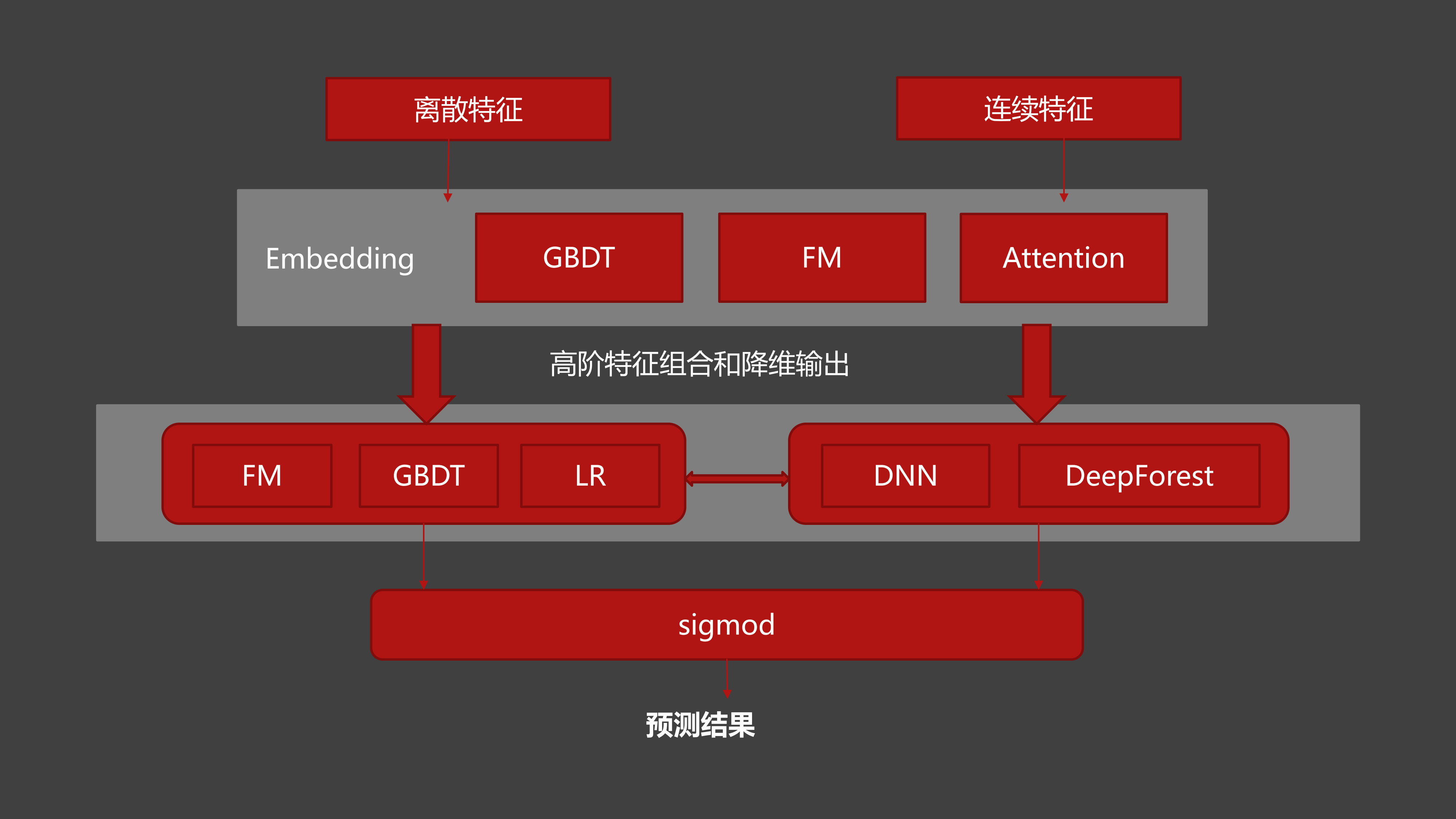
AdTiming CTO Dr. Zhang Wen Tao
In February of 2018, Alimama, in conjunction with the International Joint Conferences on
Artificial
Intelligence (IJCAI), hosted an advertising algorithm competition on the Alibaba Tianchi
Platform.
Alimama is Alibaba's big data marketing platform. It has access to all the core business data of
Alibaba. This competition hopes to uncover more technologies and talents to empower the whole
marketing ecology. Given massive transaction data, the key challenge of the competition is for
participants to produce the best conversion rate estimation algorithm. Similarly, Tencent also
hosted an algorithm competition in 2017 where the key challenge is about mobile applications’
advertisement conversion rate. There seems to be an uncanny focus for algorithm competitions on
conversion rate.
In recent years, advertisements became the increasingly important revenue channel for mobile
platform and mobile APP developers. Their need for efficienct, result-oriented, systematic and
precise advertisements placements in increasing as well. And the key determinant for
advertisement
efficiency is a marketing platform’s technical foundation and execution solutions. The
algorithms
used are therefore the key derterminants. This is why the major tech players are hosting
algorithm
competitions. The Artificial Intelligence (AI) era is driven both by data and algorithm. And
algorithms will become the core competition now that data collect and storage capabilities are
well
developed.
We now enter the period of time where the mobile internet industry is booming across the globe.
The
increasing flow of international products and integration of resource challenges allows for
increasing volume of traffic and offer significant monetization opportunities. And the essential
question that all mobile APP developers have to answer is how to effectively realize
monetization of
their user base.
Relative to these major players, third party marketing/monetizing platforms are much more agile
and
quick. They continuously improvise and sometimes reinvent new models of algorithms while at the
same
time exploring real world applications. AdTiming is a mobile marketing company that specializes
helping developers go international.
AdTiming CTO Dr. Zhang has been working in the ICT industry for numerous years. He has always
been
someone brimming with innovative ideas. Be it improvising on already very established models,
leveraging on technical prowess to bring about growth, create whole new models or discovering
actual
real-world applications. In the interview with Morketing, Dr. Zhang emphasized on scientific
application as he shared AdTiming’s advertisement product ideals. We see that similar to the
major
players, AdTiming is equally in search of efficiency.
Dr. Zhang Wen Tao is a very confident person. My first impression of him is that he has a very
composed and friendly demeanor. His speed of speaking is slightly faster than average and
carries a
technical expert’s efficient way of speaking. Although his baritone voice is of a low resonance,
his
articulates very well. All of these allows Dr. Zhang to quickly build a strong rapport with me.
Dr. Zhang told Morketing very frankly that before working in mobile marketing, he was working in
a
telecommunications company where he was in charge of big data AI automation research and
development. Dr. Zhang remarked that he initially thought the transfer from telecommunications
to
mobile marketing was challenging as the two industries’ data and needs were completely
different.
He explains that in telecommunications, the main analytic perspective for a telecommunications
company is mainly the users’ communication behavior, such as voice call duration, text message
frequency and length, and therefore map out an understanding of average user behavior. Or to
effective sell new products by analyzing big data from voice call statistics, social trends,
geographic location, etc. It is even possible to decipher which users are more willing to pay
for
premium services from these data.
Although the two industries are vastly different, there are many similarities in the way that
data
needs to be gather, processed and analyzed to make sense. The principles of data mining and
analysis
remains the same, whatever the application or industry may be.
Dr. Zhang shares that it is not difficult for what technologists like him to traverse
industries,
there are tons of research, including already-function AI models, basic parameter models that
are
readily accessible for them to tweak and apply in different environments. Big data has also
become
such a hot topic in the recent years and a significant portion of big data actually comes from
sales
traffic flow. For example, group segment tagging after identifying and categorizing users
according
to their historic searches to determine their likely preference thereby allowing for precise
marketing. All of these are highly profitable and essential tools for marketing and sales in the
modern era.
It is common knowledge that advertisements will evolve towards greater precision. There are many
companies in China that are already capable of such feats, including big data analysis and group
segment tagging. From a technical perspective, the core solutions to achieving this goal is AI
or
perhaps machine learning.
Tencent’s social media advertisement system first started out using AI ideology and methods to
estimate the conversion rate, click rate and automatically process advertisement audits. The
process
of data mining also requires AI, for example the interests of users for particular goods, user
trends and user lifestyle. And AIs are the best estimators as it can circumvent issues relating
to
privacy. AdTiming current leverages on AI to accurately estimate click rate, conversation rate,
etc.
The common practice in the industry of advertisements is to first establish a working AI model.
With
this foundation, technologists provide the model with historical data, for deep learning to
happen
and ultimately elevate predictive accuracy. On the topic of precision, the key question is how
much
data is available. Traditionally, when the data is insufficient, the estimates of algorithms
will be
considerably off, however in the context of advertisements, this is not the case. Dr. Zhang
explains
that in the advertisement industry, even if there is plenty of data, it may more likely be
non-essential. Non-essential data such as long tail traffic.
Dr. Zhang further shares that at the current stage, the AdTiming team is building and refining
algorithm for AI automated precise filtration of data. AI has been developing very rapidly in
the
past two years. A large number of models are already being used and many more still being built.
Many big companies such as Google, Alibaba, Facebook, etc. are in the midst of trying to apply
deep
learning into the contexts of advertisements. There is potential to distinguish users even in
there
are only very limited data available. It might even be possible to convert long tail traffic.
In the industry, it is already common practice to leverage on Logic Regression to predict click
rate. Many companies are using this model and the results are prominent. Broadly speaking, Logic
Regression is a type of linear model similar to the very established ARMA model.
Programmers generally hope to be able to identify the relationships between factors, but within
the
realm of advertisements, there are many observable factors, especially so the numerous sub
factors
in user identification. Therefore, the use of linear model here is very challenging.
This type of non-linear model can automatically identify and sort factors, thereby solving the
challenge.
Traditional non-linear models are gradually maturing in the current industry. With the
improvement
of technical expertise in this area, more people are now involved in deep learning models. This
is
because deep learning models hold highly non-linear capabilities, it has the potential to
explore
very exciting new areas. Allowing massive amounts of seemingly unrelated data inputs to produce
highly accurate estimates.
Deep learning models has already been around for quite some time, but why is it only applied in
recent years? Dr. Zhang informed Morketing that it was recently found that deep learning model
has
the potential to solve current challenges in the advertising landscape, however it has yet to
mature
into an established industry standard.
Firstly, deep learning requires huge amounts of data, only with substantial input can deep
learning
be useful. Secondly, in regard to data in advertising, more research is needed on the
application
and promotion structure. Lastly, as the calculations are running incessantly, it requires
significant hard and soft inputs for it to bring about possible returns. Even then, only after a
significant period of time. In addition, the reports on deep learning published by CTR suggests
that
improvements are not similar to DNN (Deep Neural Network) in other fields such as language and
visual recognition. But leveraging on DNN to build CTR models is definitely the trend and there
is
potential here to be discovered.
The major internet companies such as Google, Facebook, Microsoft and Alibaba are keenly
interested
in deep learning models, especially when applied to advertisements. Numerous publications on
this
subject in recent years primarily focus on multi-model integration as well as improvements to
the
structure of the web. These discoveries will allow advertisement data and CTR estimating models
to
become better.
AdTiming has just been around for less than two years. Dr. Zhang expresses that they are lucky
to
have the advantage of leveraging on existing established models. Standing on the shoulders of
the
pioneers. He adds that AdTiming pursues creativity extensively.
Dr. Zhang elaborates that everyone employs the same basic theories and modelling tools. To
obtain
better results, naturally, there needs to be creative techniques. For example, there are many
factors that affect the click rate of advertisements, different factors have different
characteristics and meaning, therefore if they are treated as the same, the predictive models
will
not produce the expected results. Therefore, the salience for each factor has to be individually
tweaked to achieve better results.
The AdTiming team has experienced 3 stages:
1. The initial use of the most basic logic of LR model.
2. The current use of traditional non-linear model, employing a combination of GBDT + FM models
to
achieve desirable results when applied.
3. At the same time, in the field of deep learning, AdTiming invested significant resources into
its
research and application. Attempting many DNN models, discovering new ideas while continuously
looking for simple, effect, suitable applications for marketing purposes.

In advertising industry, the integration of multiple models is the norm. The classic case
established by Facebook is a combination of GBDT and Logic Regression models, it solves the
issue of
Logic Regression needing manual factor programming. And the results were objectively improved.
The
industry is always trying new models, always improving the structure and parameters to finetune.
Likewise, AdTiming is also doing so diligently. Recently, AdTiming constructed a new model
Deep
Forest. This model is highly capable in its potential to integrate non-linear hidden
data.
Additionally, the model is simpler than DNN and it allows for concurrent processing. Deep
Forest also functions well with a smaller data pool. After some optimization, the
results are
rather positive, and at the very least, it is on par with DNN. It easily meets the requirements
of
advertising needs.
Dr. Zhang concluded that deep learning in itself is a foundational theory. But when applied to
estimate advertisement click rates, visual recognition, automated language processing and
identification of various factors, it allows for the model to produce remarkably accurate
estimates.
Thereby enabling more effective advertisement placements.